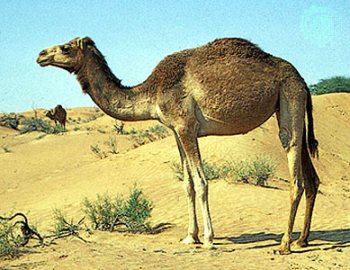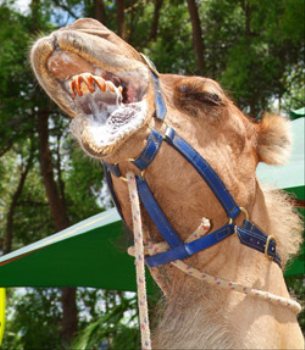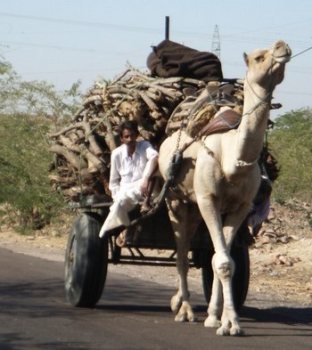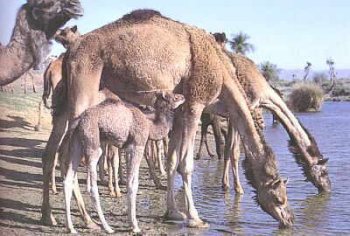The Camelus Dromedarius.
The Dromedary camel (Camelus dromedarius) is a
large even-toed ungulate. It is often referred to as the one-humped camel,
Arabian camel, or simply as the "dromedary". Its native range is unclear, but it
was probably the Arabian Peninsula. The domesticated form occurs widely in
northern Africa and the Middle East; the world's only population of dromedaries
exhibiting wild behaviour is an introduced feral population in Australia.
The dromedary camel is arguably the best-known member of the camel family. Other
members of the camel family include the Ilama and the alpaca in South America.
The Dromedary has one hump on its back, in contrast to the Bactrian
camel which has two. A good mnemonic for remembering which way around these
terms apply is this: "Bactrian" begins with "B", and "Dromedary" begins with
"D"; "B" on its side has two humps, whilst "D" on its side has only one
hump.
The camel in his natural environment. At work and complaining. The two-humped Bactrian.
Camels are very suited for their harsh environment....aside
from their ability to store fat in their hump for emergency energy, they have
flat, padded feet which are perfect for walking on loose, hot sand. During
sandstorms, the camel can close up it's nostrils to keep from inhaling the hot
grains of sand and hunker down into a sort of ball to wait for the storm to
subside. These animals also provide food
and clothing for the
people who inhabit their area of the
world and their skins provide
shelter, so the camel has become one of the most important beasts
of burden in the world.
In some ways the camel is more reliable
than the tractor. Modern / Western clothes but the form of transport and scenery traditional. The thirsty gang.
Adult males grow to a height of 1.8–2.0 m, and females to 1.7–1.9 m. The weight is usually in the range
of 400–600 kg for males, with females
being 10% lighter. They show remarkable adaptability in body temperature, from
34 °C to 41.7 °C, this being an adaptation to conserve
water. Male dromedaries have a soft palate, which they inflate to produce a deep
pink sack, which is often mistaken for a tongue, called a doula in Arabic,
hanging out of the sides of their mouth to attract females during the mating
season. Dromedaries are also noted for their thick eyelashes and small, hairy
ears. A camel's mating season is year-round and will almost always occur
whenever there is an abundance of food material ( between the months of
February and May). The gestation period is from 400 to 425 days and the
resulting in the birth of a single baby calf.
There is a 2 year birth interval between calves. The lifespan of the
Dromedary camel is from 10 to 15 years.

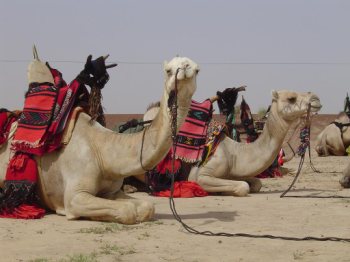
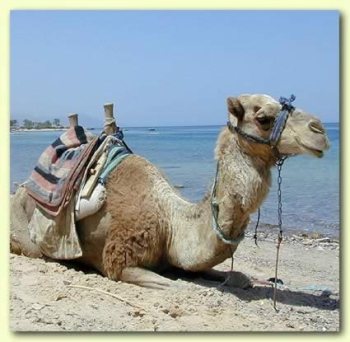
Dromedaries were first domesticated in
central or southern Arabia some thousands of years ago. Experts are divided
regarding the date: some believe it was around 4000 BC, others as recently as
1400 BC. There are currently almost 13 million domesticated dromedaries, mostly
in the area from Western India via Pakistan through Iran to northern Africa.
None survive in the wild in their original range, although the escaped
population of Australian feral camels is estimated to number at least 300,000.
Around the second millennium BC, the dromedary was introduced to Egypt and North
Africa. In the Canary Islands, the dromedaries were introduced recently as
domestic animals.
Although there are several other
camelids, the only other surviving species of true camel today is the Bactrian
Camel. The Bactrian camel was domesticated sometime before 2500 BC in Asia, well
after the earliest estimates for the dromedary. The Bactrian camel is a
stockier, hardier animal, being able to survive from Iran to Tibet The dromedary
is taller and faster: with a rider they can maintain 8-9 mph (13-14.5 km/h) for hours at a time. By
comparison, a loaded Bactrian camel moves at about 2.5 mph (4 km/h).


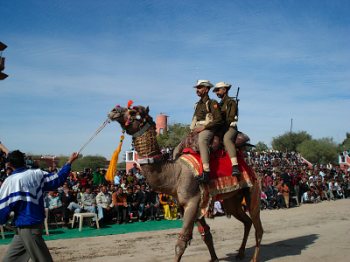
Camels being loaded for war work in 1940. The
Indian guard and mounted
soldiers.
Unlike horses, they kneel for the loading of passengers and
cargo. A camel's long, thin legs have powerful muscles which allow the animal to
carry heavy loads over long distances. They can carry as much as 450 kgs or 990
lbs, but a usual and more comfortable cargo weight is 150kgs/330lbs. It is usual
for a camel to work as a beast of burden for only six to eight months of the
year; the remainder of the time it needs to rest and recuperate. Dromedaries
have an ill-deserved reputation for being bad-tempered and obstinate creatures
that spit and kick. In reality, they tend to be amiable, patient, and
intelligent. A camel will show displeasure by stamping its feet and running,
usually if man has loaded him with too much weight. At many of the desert
located tourist sites in Egypt, police mounted on camels can be seen. A camel
can go 5-7 days with little or no food and water, and can lose a quarter of its
body weight without impairing its normal functions. These days, camels rely on
man for their preferred food of dates, grass and grains such as wheat and oats,
but a working camel travelling across an area where food is scarce can easily
survive on thorny scrub or whatever it can find - bones, seeds and dried leaves,
even tents. They have three stomachs which allows the camel to partially digest
their food and then regurgitate it to finish the chewing and digestion
process. These vegetarians are truly unique in their ability to squeeze
nutrients from the driest, most unappetizing pieces of plant material
imaginable. Some grasses and plants on the desert contain 50% water. This helps
the camel to be able to ingest enough water to keep from dehydrating.
These animals can go over 90 days without water but when water is readily
available, they may drink as much as 35 to 40 gallons at a sitting. They
store fat in their hump which is used as energy whenever food is scarce.
If camels are not able to get food or water for several months...their hump will
become almost non-existent, but will rapidly "rebuild" after proper food and
water has been ingested.
All camels moult in spring and have grown a new coat by autumn. Camel hair is
sought after world-wide for high-quality coats, garments and artists' brushes,
as well as being used to make traditional Bedouin rugs and tents. A camel can
shed as much as 2.25 kilos/5lbs of hair at each moult.

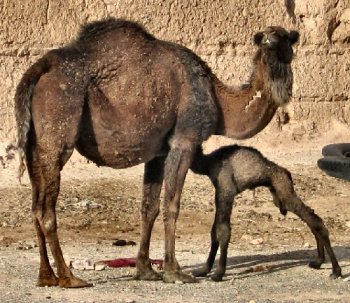
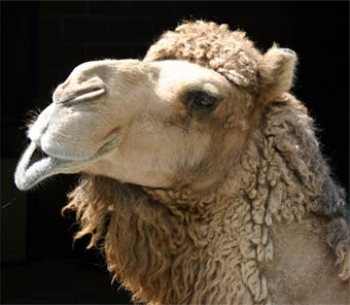
Around the second millennium BC, camels had become established
in the Sahara region but disappeared again from the Sahara beginning around 900
BC. The Persian invasion of Egypt under Cambyses introduced domesticated camels
to the area. Domesticated camels were used through much of North Africa, and the
Romans maintained a corps of camel warriors to patrol the edge of the desert.
The Persian camels, however, were not particularly suited to trading or travel
over the Sahara; rare journeys made across the desert were made on horse-drawn
chariots. The stronger and more durable Dromedaries first began to arrive in
Africa in the fourth century. It was not until the Islamic Conquest of North
Africa, however, that these camels became common. While the invasion was
accomplished largely on horseback, the new links to the Middle East allowed
camels to be imported en masse. These camels were well-suited to long
desert journeys and could carry a great deal of cargo. For the first time this
allowed substantial trade over the Sahara.
All in all a really useful creature and at about £475.00 each a
bargain. So when I offered you for 10 camels........................
See Bear RUN
.........................

